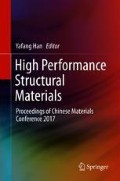Abstract
Residual stress of aluminum alloy thick plates causes distortion in subsequent machining operations for aircraft components. During spray quenching the different cooling rates applied across the plate thickness to produce residual stresses. If differential cooling is applied to the upper and lower surfaces, this could lead to an asymmetric distribution of residual stress on both sides of plate. This in turn causes potentially uncontrollable part distortion and dimensional inaccuracy during the machining operation. In this study, a finite element (FE) model, taking into account of the different cooling intensity on the upper and lower surfaces, was established to predict the residual stress. Residual stress was measured using an ultrasonic stress measuring apparatus. The results showed that the residual stress on the upper surface was −174 MPa when the applied water flux was 350 m3/h, and −194 MPa on the opposite surface where the corresponding water flux was 300 m3/h. This was found to be in good agreement with the simulation results. It was found that the residual compressive stress on the surface with the higher cooling intensity was smaller than the side with lower intensity which is contrary to conventional wisdom. Therefore, based on the difference of cooling intensity on the two surfaces, the guidance for utilizing the roller-quenching-equipment can be derived finally.
Access this chapter
Tax calculation will be finalised at checkout
Purchases are for personal use only
References
T. Wang, Z. Yin, Research status and development trend of ultrahigh strength aluminum alloys, Chinese Journal of Rare Metals. 30 (2006) 197–202.
M. Cao, Y. Wu, H. Gong, Z, Yang, Simulation and Analysis of Temperature Field and Stress Field for 7050 Al Alloy, Hot Working Technology. 44 (2015) 202–205.
Y. Ke, H. Dong, Pre-stretching process and its application in reducing residual stress of quenched 7075 aluminum alloy thick-plates, The Chinese Journal of Nonferrous Metals. 14 (2004) 639–645.
T. Zhang, H. Ding, L Pu, Simulation Research on Temperature Filed and Thermal Stress Field of 7050 Aluminum Alloy Part in Quenching Process, Hot Working Technology. 42 (2013)149–152.
S. Cao, Study on non-uniform heat transfer and cooling characteristics of spray quenching of aluminum alloy thick plate, Master of Central South University (2011).
S. Cao, C. Xiong, Y Deng, X. Zhang, Effect of single-side injection quenching parameters on cooling of 7050 aluminum alloy plate, Journal of Aeronautical Materials. 31 (2011) 31–35.
S. Guo. Experimental and Simulation Study on spray quenching of 7050 aluminum alloy, Master of Central South University (2010).
Y. Li, Y. Wu, H. Gong, F. Xiao, FEM and Contour Method Study of Quenching Residual Stress of 7050 Aluminum Alloy Cross-Shaped Component, Materials Science Forum, Trans Tech Publications, 887 (2017) 89–95.
C. Xiong, Y. Deng, J. Zhang, X. Zhang, Thermal simulation on surface heat transfer coefficient during quench of 7050 Al alloy by water spraying, Materials Science and Engineering of Powder Metallurgy. 15 (2010) 421–426.
T. Zhang, H. Ding, L. Pu, Simulation Research on Temperature Filed and Thermal Stress Field of 7050 Aluminum Alloy Part in Quenching Process, Hot Working Technology. 42 (2013) 149–152.
J. Wang, J. Han, J. P. Domblesky, W. Li, Z. Yang, Y. Zhao, Predicting distortion in butt welded plates using an equivalent plane stress representation based on inherent shrinkage volume, Journal of Manufacturing Science and Engineering. 138 (2016) 011–012.
K. Qin, J. Cui, Experimental research and numerical simulation for the temperature field in the casting of aluminum alloys, Journal of plasticity engineering. 14 (2007) 16–19.
C. Xu, W. Song, Q. Pan, X. Li, X. Jin, H. Liu, Residual stress nondestructive testing method using ultrasonic, Nondestructive Testing. 36 (2014) 25–31.
Y. Deng, S. Guo, C. Xiong, X. Zhang, Effect of water spraying parameters on heat transfer coefficient of 7050 aluminum alloy during quench, Journal of Aeronautical Materials. 30 (2010) 21–26.
J. Wang, Y. Kang, C. Li, Phase Diagram and Phase Equilibrium Studies on Ultra High Temperature Alloys of Nb-Si-Ti, Materials Science Forum. 849 (2016) 618–625.
Author information
Authors and Affiliations
Corresponding author
Editor information
Editors and Affiliations
Rights and permissions
Copyright information
© 2018 Springer Nature Singapore Pte Ltd.
About this paper
Cite this paper
Wang, J., Niu, G., Yang, Z., Cao, H., Liu, C. (2018). Influence of Cooling Intensity Difference Between Upper and Lower Surface to the Residual Stress Distribution of 7050 Aluminum Alloy Plates. In: Han, Y. (eds) High Performance Structural Materials. CMC 2017. Springer, Singapore. https://doi.org/10.1007/978-981-13-0104-9_24
Download citation
DOI: https://doi.org/10.1007/978-981-13-0104-9_24
Published:
Publisher Name: Springer, Singapore
Print ISBN: 978-981-13-0103-2
Online ISBN: 978-981-13-0104-9
eBook Packages: Chemistry and Materials ScienceChemistry and Material Science (R0)

